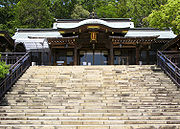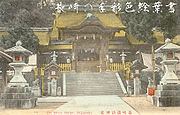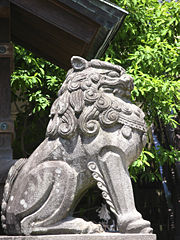
Suwa Shrine (Nagasaki)
Encyclopedia


Japan
Japan is an island nation in East Asia. Located in the Pacific Ocean, it lies to the east of the Sea of Japan, China, North Korea, South Korea and Russia, stretching from the Sea of Okhotsk in the north to the East China Sea and Taiwan in the south...
, and home to the Nagasaki Kunchi (kunchi (くんち) means "festival
Festival
A festival or gala is an event, usually and ordinarily staged by a local community, which centers on and celebrates some unique aspect of that community and the Festival....
"). It is located in the northern part of the city, on the slopes of Mount Tamazono-san, and features a 277-step stone staircase leading up the mountain to the various buildings that comprise the shrine.
Suwa shrine was established as a way of stopping and reverting the conversion to Christianity
Christianization
The historical phenomenon of Christianization is the conversion of individuals to Christianity or the conversion of entire peoples at once...
that was taking place in Nagasaki. In modern times it remains an important and successful center of the community.
The shrine in Nagasaki is one of many Suwa shrines
Suwa Shrine
A is a shinto shrine part of the shrine network headed by Suwa Taisha. There are many Suwa Shrines in Japan. Famous Suwa Shrines are as follows.*Suwa Taisha -- Sōhonsha of Suwa Shrines.*Suwa Shrine *Suwa Jinja *Akita Suwa Gū...
, all of which are dedicated to Suwa-no-Kami, a kami
Kami
is the Japanese word for the spirits, natural forces, or essence in the Shinto faith. Although the word is sometimes translated as "god" or "deity", some Shinto scholars argue that such a translation can cause a misunderstanding of the term...
of valor and duty, and are linked with Suwa Taisha
Suwa Taisha
, or Suwa Grand Shrine, is a Shinto shrine in Nagano prefecture, Japan. Over 1200 years old, it is one of the oldest shrines in existence, and is mentioned in the Kojiki, an 8th century text...
, the head shrine of Suwa-no-Kami worship. Two other kami spirits are also enshrined at Suwa shrine, all three of which are celebrated during the Kunchi.
History
The official date of construction for Suwa Shrine is 1614, the same year as Tokygawa Ieyasu'sTokugawa Ieyasu
was the founder and first shogun of the Tokugawa shogunate of Japan , which ruled from the Battle of Sekigahara in 1600 until the Meiji Restoration in 1868. Ieyasu seized power in 1600, received appointment as shogun in 1603, abdicated from office in 1605, but...
Edict against Christianity
Christianity
Christianity is a monotheistic religion based on the life and teachings of Jesus as presented in canonical gospels and other New Testament writings...
, although there was little more than a small structure to mark the position of the future shrine at this time. At that time, Nagasaki was home to the largest Christian population in Japan, and had destroyed many of the former Shinto
Shinto
or Shintoism, also kami-no-michi, is the indigenous spirituality of Japan and the Japanese people. It is a set of practices, to be carried out diligently, to establish a connection between present day Japan and its ancient past. Shinto practices were first recorded and codified in the written...
shrines and Buddhist temple
Temple
A temple is a structure reserved for religious or spiritual activities, such as prayer and sacrifice, or analogous rites. A templum constituted a sacred precinct as defined by a priest, or augur. It has the same root as the word "template," a plan in preparation of the building that was marked out...
s. The Tokugawa Shogunate
Tokugawa shogunate
The Tokugawa shogunate, also known as the and the , was a feudal regime of Japan established by Tokugawa Ieyasu and ruled by the shoguns of the Tokugawa family. This period is known as the Edo period and gets its name from the capital city, Edo, which is now called Tokyo, after the name was...
had taken power and reversed its friendly policy towards Christianity. The government had begun forcing Christians to reconvert to the Japanese religions of Buddhism and Shinto
Shinbutsu Shugo
, literally "syncretism of kami and buddhas" is the syncretism of Buddhism and kami worship which was Japan's religion until the Meiji period...
. It was thought that establishing a major point of Shinto worship would be important to these efforts, giving the local population a central point of worship and a sense of community.
The temporary structure was frequently attacked by resisting Christians, until 1624 when Aoki Kensei came to Nagasaki. His religious zeal and skill at organizing, combined with authority granted by the leading Yoshida Shinto council, led to the completion of the main structure of Suwa Shrine. In order to attract attention and encourage attendance at the new shrine, a dramatic yutate-sai ritual, where a priest demonstrates his communion with the kami by plunging his hands into boiling water unharmed, was performed. In spite of this, as well as the sumo match
Sumo
is a competitive full-contact sport where a wrestler attempts to force another wrestler out of a circular ring or to touch the ground with anything other than the soles of the feet. The sport originated in Japan, the only country where it is practiced professionally...
that followed, very few people came to watch.
In 1634, an edict was issued requiring all people to register at the shrine and be counted. In addition to this, in another attempt to further increase local participation in shrine events, a great autumn festival
Japanese festivals
Japanese festivals are traditional festive occasions. Some festivals have their roots in Chinese festivals but have undergone dramatic changes as they mixed with local customs....
was held at the shrine. Both of these events were created in the attempt to discover any remaining Christians, who would not be able to participate in the festival or register at the shrine. Anyone who failed to do so was arrested, tortured and possibly executed if they did not renounce their Christian faith.
Because Nagasaki was the only place in Japan with an open port
Dejima
was a small fan-shaped artificial island built in the bay of Nagasaki in 1634. This island, which was formed by digging a canal through a small peninsula, remained as the single place of direct trade and exchange between Japan and the outside world during the Edo period. Dejima was built to...
, it was considered essential to impress the Dutch
Netherlands
The Netherlands is a constituent country of the Kingdom of the Netherlands, located mainly in North-West Europe and with several islands in the Caribbean. Mainland Netherlands borders the North Sea to the north and west, Belgium to the south, and Germany to the east, and shares maritime borders...
and Chinese
China
Chinese civilization may refer to:* China for more general discussion of the country.* Chinese culture* Greater China, the transnational community of ethnic Chinese.* History of China* Sinosphere, the area historically affected by Chinese culture...
traders with Japanese culture. In addition to the grand festival, beginning in 1638 major performances of Noh
Noh
, or - derived from the Sino-Japanese word for "skill" or "talent" - is a major form of classical Japanese musical drama that has been performed since the 14th century. Many characters are masked, with men playing male and female roles. Traditionally, a Noh "performance day" lasts all day and...
were also held at Suwa shrine, at the direct command of the Shogun. These performances continued until 1856, when a major fire at the shrine destroyed most of the expensive Noh masks and props.
From 1871 through 1946, Suwa was officially designated one of the , meaning that it stood in the mid-range of ranked, nationally significant shrines
Modern system of ranked Shinto Shrines
The The The (sometimes called simply , was an organizational aspect of the establishment of Japanese State Shinto. This system classified Shinto shrines as either official government shrines or "other" shrines...
.
Suwa Shrine survived the atomic bombing of Nagasaki
Atomic bombings of Hiroshima and Nagasaki
During the final stages of World War II in 1945, the United States conducted two atomic bombings against the cities of Hiroshima and Nagasaki in Japan, the first on August 6, 1945, and the second on August 9, 1945. These two events are the only use of nuclear weapons in war to date.For six months...
on August 9, 1945. It is thought to have survived intact due to its strategic location in the central part of Mount Tamazono-san's southern flank, although in the aftermath of the bomb local residents were quick to note that while the famous Urakami Cathedral
Urakami Cathedral
St. Mary's Cathedral, often known as Urakami Cathedral after its location Urakami, is a Roman Catholic church located in Motoomachi, Nagasaki, Japan.- History :...
and surrounding Catholic neighborhoods were obliterated, the Shinto shrine still stood.
This was considered to be significant by the survivors of the bombing, showing the power of the native Japanese kami as opposed to the imported Christian god
God the Father
God the Father is a gendered title given to God in many monotheistic religions, particularly patriarchal, Abrahamic ones. In Judaism, God is called Father because he is the creator, life-giver, law-giver, and protector...
. In addition, priests from Suwa Shrine took an active role in the rebuilding of Nagasaki, including consecrating the land and purifying structures that still stood.
In 1984, a large-scale reconstruction repaired and modernized the shrine, installing such conveniences as air conditioners and glass windows. This reconstruction was controversial, as some felt that modern conveniences had no place at a traditional shrine.
Festivals

Shichi-Go-San
is a traditional rite of passage and festival day in Japan for three- and seven-year-old girls and three- and five-year-old boys, held annually on November 15...
and the coming-of-age festival
Seijin shiki
is a Japanese holiday held annually on the second Monday of January. It is held in order to congratulate and encourage all those who have reached the age of majority over the past year, and to help them realize that they have become adults...
.
Suwa Shrine is also the host to many annual festivals. These festivals serve the joint purpose of honoring the kami, providing a sense of community for shrine worshipers, and providing exposure and income for the shrine itself. Some of these festivals are typical to all major Shinto shrines in Japan, but some are unique to Suwa shrine.
- Atomic bomb commemorative service - This festival is probably unique in all of Japan, in that it combines elements of Christian, Buddhist and Shinto worship to pray for the more than 70,000 people killed by the atomic bomb dropped on Nagasaki. It takes place every year on August 9th.
- Doll's Festival - Like all of Japan, Suwa Shrine observes the Doll's Festival on March 3rd. However, since the 1980s the festival has been observed in an unusual way, in that attractive, 20-year old women are selected to wear the shrine's collection of antique kimonoKimonoThe is a Japanese traditional garment worn by men, women and children. The word "kimono", which literally means a "thing to wear" , has come to denote these full-length robes...
and pose in a live Doll's Day procession. The competition amongst the young women is fierce, and there are far more applicants than positions in the festival. The two most beautiful women are chosen for the key roles of the Emperor and Empress in the procession. This tradition was created largely as a media eventMedia EventA media event, as loosely defined by evolving modern usage, is an occasion or happening, spontaneous or planned, that attracts prominent coverage by mass media organizations, particularly television news and newspapers in both print and Internet editions....
to promote and advertise Suwa shrine, and every year television crews are invited to broadcast the festival.

- Kunchi - The most famous of Suwa Shrine's festivals, this festival began along with the founding of the shrine as a way to both demonstrate its new importance in the community and as a way to hunt for Hidden ChristiansKakure Kirishitanis a modern term for a member of the Japanese Catholic Church that went underground after the Shimabara Rebellion in the 1630s.-History:Kakure Kirishitans are called the "hidden" Christians because they continued to practice Christianity in secret. They worshipped in secret rooms in private homes...
. Kunchi is held from October 7 to 9 every year and is considered one of the major festivals of JapanJapanJapan is an island nation in East Asia. Located in the Pacific Ocean, it lies to the east of the Sea of Japan, China, North Korea, South Korea and Russia, stretching from the Sea of Okhotsk in the north to the East China Sea and Taiwan in the south...
, along with the Gion MatsuriGion MatsuriThe takes place annually in Kyoto and is one of the most famous festivals in Japan. It spans the entire month of July and is crowned by a parade, the on July 17. It takes its name from Kyoto's Gion district....
and Osaka's Tenjin Matsuri. It has been designated as an Important Intangible Cultural Asset.
- Yutate-sai - A theatrical ritual, originally performed by yamabushiYamabushi' are Japanese mountain ascetic hermits with a long tradition as mighty warriors endowed with supernatural powers. They follow the Shugendō doctrine, an integration of mainly esoteric Buddhism of the Shingon sect, with Tendai and Shinto elements...
, a priest demonstrates his communion with the kami by plunging his hands into boiling water unharmed. This ritual was performed on the opening of Suwa shrine, and is continued to be performed to this day. It is very rare at other Shinto shrines.
English language fortunes
Most Shinto shrines sell OmikujiOmikuji
Omikuji are random fortunes written on strips of paper at Shinto shrines and Buddhist temples in Japan. Literally "sacred lot", these are usually received by making a small offering and randomly choosing one from a box, hoping for the resulting fortune to be good...
, a type of fortune telling that comes on a slip of paper that lists your particular luck at that time. Suwa shrine was the first shrine in Japan to offer Omikuji in English.
The fortunes are divided into
- Best luck
- Average luck
- Good luck
- Half luck
- Partly bad luck
- Worst luck
- Bad luck but turns good
- Luck in the end
Stop lions
Another unique feature of Suwa shrine are the "stop lions". They are two stone-carved guardian lionsImperial guardian lions
Chinese guardian lions, known as Shishi lions or Imperial guardian lion, and often incorrectly called "Foo Dogs" in the West, are a common representation of the lion in pre-modern China...
, and tradition holds that if one wishes to stop a behavior, such as smoking
Smoking cessation
Smoking cessation is the process of discontinuing the practice of inhaling a smoked substance. This article focuses exclusively on cessation of tobacco smoking; however, the methods described may apply to cessation of smoking other substances that can be difficult to stop using due to the...
, one should tie a piece of paper or string around their front legs and pray for their assistance.
Further reading
- Nelson, John K. Historical monuments at Nagasaki Suwa shrine
- Gerstman, Bruce Suwa Shrine story

